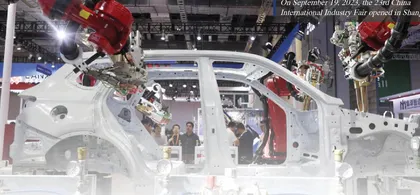International Supply Chain Cooperation and China’s Role
作者: Su Qingyi

In recent years, the challenges facing the development of international supply chains have been increasing. Major country competition, COVID pandemic and geopolitical conflicts have impacted the development of international supply chains and continue to have negative effects. Against this background, the international community should cooperate to deal with the risks and challenges.
International Supply Chain Development Faces Four Major Challenges
The international supply chain is a mode of division of labor in which all countries contribute to the production of a product. Since the 1980s, especially after the end of the Cold War, the international supply chain has experienced a golden age of rapid development, and the degree of division of labor has been deepening. However, the international supply chain is now facing four major challenges, such as limited development potential, the rise of trade protectionism and anti-globalization headwinds, the increasingly intense competition among major countries, and the increase in objective shocks.
Firstly, multiple factors have led to the bottleneck in the development of international supply chains. From the perspective of international trade, international supply chain is a mode of division of labor. The international division of labor refers to the division of production across national boundaries among countries (regions) in the world, which is affected by factors such as the distribution of production factors, the level of scientific and technological development and the international political and economic order. At present, inter-industry, intra-industry and intra-product division of labor are the three main forms of international division of labor, in which intra-product division of labor (international supply chain) occupies a dominant position.
Between the late 1980s and the early 1990s, advances in information technology, declining international transportation costs and institutional changes reduced the costs of cross-border economic activities and accelerated the deepening of the intra-product division of labor. Especially in the early 1990s, against the backdrop of the collapse of the Soviet Union and the dramatic changes in Eastern Europe, China’s reform and opening-up continued, breaking down the economic and trade restrictions between the East and West camps, and the volume of foreign trade has been on the rise. The scope and proportion of intra-product division of labor is getting wider and wider, and its increase is much higher than that of inter-industry division of labor and intra-industry division of labor.
At present, the development of international supply chain has entered a bottleneck, and the proportion of trade in international supply chain in the total global trade in goods can hardly break through 50%. After the international financial crisis in 2008, the development of the breadth and depth of countries’ participation in the international supply chain, and the length of international supply chain has stagnated. The development of international supply chains and the tapping of their potential need to be supported by fundamental factors such as reducing trade costs and technological transformation. It is difficult to further deepen the division of labor in international supply chains without new trade liberalization and technological transformation. As a result, the growth of global trade in goods has also experienced a relative downturn, and its share of world GDP is difficult to exceed 30%.
Secondly, the rise of trade protectionism and anti-globalization headwinds has disrupted the stability of the international supply chain. In recent years, trade protectionism and anti-globalization have been on the rise, spreading from the private to the governmental level in developed countries such as the U.S. and European countries. Globally, an average of 223 new trade and investment restrictive measures have been added each year, and only 61 new trade and investment liberalization measures have been added. Among them, the U.S. has introduced significantly more trade and investment restrictive measures than other countries, accounting for 7.43% of all restrictive measures. Especially during Trump’s presidency of the U.S., the country’s protectionism has become more and more serious. In February 2018, the U.S. imposed tariffs of 30% and 50% on imports of solar panels and washing machines, respectively, based on the “201 investigation”. In March, based on the “232 investigation”, the U.S. imposed tariffs on steel, aluminum of 25% and 10% respectively. It even launched a “trade war” against China based on the “301 investigation”. And since 2017, the U.S. has revised and implemented the Foreign Investment Risk Review Modernization Act to strengthen the review of foreign investment in the U.S.. The Biden administration has not changed the relevant trade policies of the Trump administration since it came to power.
Thirdly, the major country competition and geopolitical conflicts hinder the development of international supply chains. With China’s economic strength getting closer and closer to the U.S., the U.S. strategic anxiety has increased. And the comprehensive containment and suppression of China has seriously undermined the healthy and stable development of the international supply chain. The major country competition mainly affects the development of international supply chains in four dimensions: